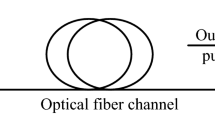Abstract
This paper presents the performance signature of the engagement of hybrid symmetrical hybrid compensation techniques for ultra wide bandwidth and ultra long haul optical transmission systems. These schemes that are namely optigrating, ideal dispersion compensation fiber Bragg Grating (IDCFBG), and dispersion compensation fiber (DCF). The combination of mixing these techniques together which is called hybrid symmetrical dispersion compensation techniques in that case. The employment of these mixing schemes is in symmetrical configuration with the presence of Erbium doped fiber amplifiers in order to upgrade optical fiber system capacity to reach transmission distance up to 432 km and transmission data rate up to 320 Gb/s. Maximum signal quality factor, minimum bit error rate (BER), output optical signal to noise ratio, electrical received power after APD photodetector, noise figure, and gain are the major interesting performance parameters for measuring the system operation efficiency. It is observed that the optimum case for maximum quality factor and minimum BER is achieved with 15 m EDFA amplifier length and 150 mW EDFA pump power.














Similar content being viewed by others
References
Panda, T., Mishra, R. K., Parakram, K., & Sinha, A. (2016). Performance comparison of dispersion compensation in a pre, post and symmetrical arrangement using DCF for long haul optical communication. International Journal of Engineering & Technology,3(7), 14–20.
Meenakshi, J., & Malhotra, J. (2015). Comparative analysis of different dispersion compensation techniques on 40 Gbps DWDM system. International Journal of Technology Enhancements and Emerging Engineering Research,3(6), 34–38.
Kumar, S., Jaiswal, A. K., Kumar, Er. M., & Saxena, Er. R. (2013). Performance analysis of dispersion compensation in long haul optical fiber with DCF. IOSR Journal of Electronics and Communication Engineering (IOSR-JECE), 6(6), 19–23.
Kaur, M., Sarangal, H., & Bagga, P. (2015), Dispersion compensation with dispersion compensating fibers (DCF). International Journal of Advanced Research in Computer and Communication Engineering, 4(2), 354–356.
Verma, A. S., Jaiswal, A. K., & Kumar, M. (2013). An improved methodology for dispersion compensation and synchronization in optical fiber communication networks. International Journal of Emerging Technology and Advanced Engineering,3(5), 769–775.
Zhou, Y., Shao, Y., Wang, Z., Li, C., Zhou, J., & Ma, W. (2016). Research on dispersion compensation of 40 GB/s optical duo-binary coded transmission system. Optics and Photonics Journal,6, 190–195.
Abdulwahed, Saif H., & Abass, Tabarak M. (2016). 8 × 10 Gbps optical system with DCF and EDFA for different channel spacing. International Journal of Advanced Computer Research,6(24), 100–106.
Dev, S., & Kumar, S. (2016). Dispersion Compensation in optical fiber communication using Bragg Grating. In 3rd international conference on recent innovation in science, technology and management (ICRISTM-16) at Indian Federation of United Nations Associations (IFUNA) C-6, Qutab Institutional Area, New Delhi, India on 18th September 2016 (pp. 131–137). ISBN: 978-81-932712-7-8.
Haider, S., Srivastava, D. K., & Kumar, R. (2016). Performance analysis of effect of fiber length, input power and attenuation coefficient on dispensation compensation using FBG. International Journal of Advanced Research in Computer and Communication Engineering,5(9), 493–500.
Rao, R., & Kumar, S. (2016). Performance analysis of dispersion compensation using FBG and DCF in WDM systems. In 4th international conference on recent innovation in science, technology and management (ICRISTM-16) at Indian Federation of United Nations Associations (IFUNA) C-6, Qutab Institutional Area, New Delhi, India on 1st October 2016 (pp. 170–174). ISBN: 978-81-932712-8-5.
Singh, G., Saxena, J., & Kaur, G. (2014). Dispersion compensation using FBG and DCF in 120 Gbps WDM system. International Journal of Engineering Science and Innovative Technology (IJESIT),3(6), 514–519.
Gopika, P., & Thomas, S. A. (2015). Performance analysis of dispersion compensation using FBG and DCF in WDM systems. International Journal of Advanced Research in Computer and Communication Engineering,4(10), 223–226.
Day, D., & Neha. (2014). Compensation in optical fiber WDM system using different compensation techniques. International Journal of Advanced Research in Computer Science and Software Engineering,4(5), 744–751.
Ismail, T. (2014). Optical communication system and amplifier design software, March 2014 (pp. 1–24). https://www.scholar.cu.edu.eg/?q=hmostafa/files/optisystem_d1.pdf
OptiSystem Tutorials. (2014). Optical communication system design software version 13 (Vol. 1, pp. 1–500). https://dru5cjyjifvrg.cloudfront.net/wp-content/uploads/2015/03/OptiSystem_Tutorials_Volume_1.pdf
Author information
Authors and Affiliations
Corresponding author
Additional information
Publisher's Note
Springer Nature remains neutral with regard to jurisdictional claims in published maps and institutional affiliations.
Rights and permissions
About this article
Cite this article
Rashed, A.N.Z., Tabbour, M.S.F. The Engagement of Hybrid Dispersion Compensation Schemes Performance Signature for Ultra Wide Bandwidth and Ultra Long Haul Optical Transmission Systems. Wireless Pers Commun 109, 2399–2410 (2019). https://doi.org/10.1007/s11277-019-06687-2
Published:
Issue Date:
DOI: https://doi.org/10.1007/s11277-019-06687-2




